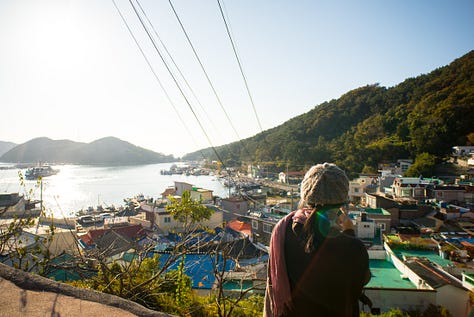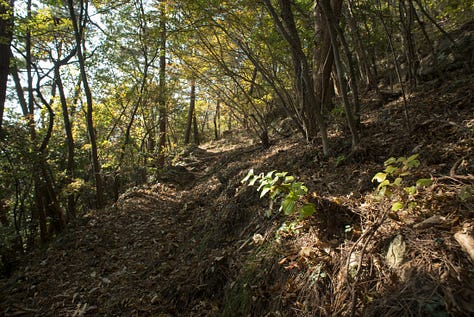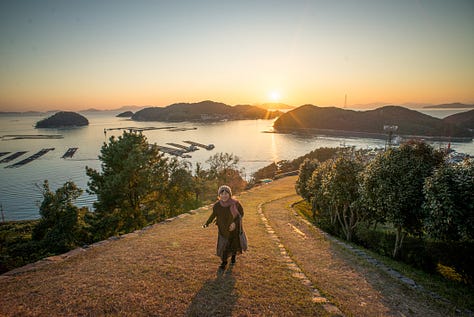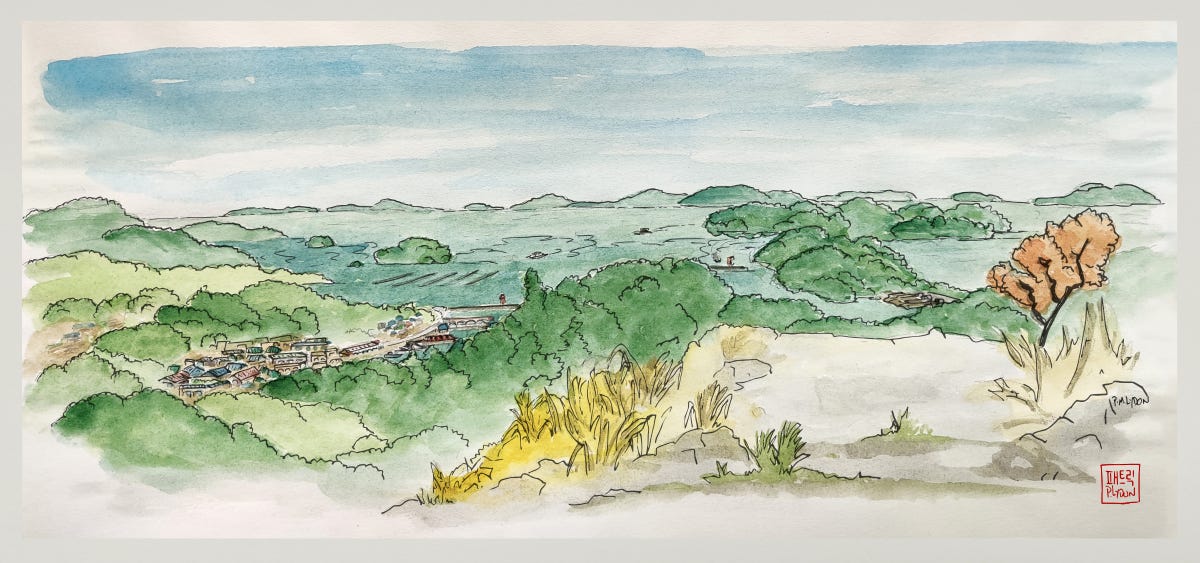“Where should we go?” Suhee’s question caught me off guard. We had long wanted to have a place of our own, but we just finished rebuilding our third shop in a leased space. Was now really the time to pick up and start over?
This is the third essay in a series on our ten year journey to find “home” in East Asia, and the unexpected turns along the way. If you’re new here, you might want to start with one of the previous writings:
| Part 1: The Search for Home | Part 2: Every Path is Possible | Part 3: House by House |
—
As much as we like Daejeon, there is a constant feeling that we are hitting walls which can not be climbed. One of those walls is the wall of cold that hits my body every winter. In asking “where should we go,” Suhee is reminding us that, even though we might feel tied down to what we built here, we can always try another way — even if that means moving somewhere else.
My reply to Suhee is immediate.
“Tongyeong. Let’s go to Tongyeong.”
After I speak these words, Suhee thumbs through her phone for something. Looking up at her across the bar, I verbalize my thought process. “I know we just finished remodeling this space. We put a lot into it. But everything is temporary. What if we found a place that worked better for us — a place we could actually afford to buy? Not just a home, but a place where we can show people that it is actually possible to live a more beautiful, ecological, fulfilling life in the city, without a lot of money. The place doesn’t have to be pretty. We can make it pretty. And we’re not getting any younger. We could pack up now, and just try to make it. We could do it tomorrow, if we wanted.”
As I ramble on, Suhee does not seem to be listening. She is busy swiping and tapping her phone like a possessed woman. I want to see if she is paying attention, so I gently prod.
“Suhee?”
“Got it.” she smiles and holds up her phone. “Seaside property in Tongyeong. It’s in our budget.”
“Are you serious?”
She is.
A Visit to Tongyeong
One week later, we step off a public bus and are standing on a hillside in Tongyeong, looking at the land that Suhee found on her phone. The property is shady. It is far up a narrow path with no utilities. There is also no hanok, just an empty piece of land. While we could afford it, but building something on it seems difficult.
Still, this area is beautiful, so instead of hanging our heads, we take a walk.
The city of Tongyeong is home to some 140,000 people, and while it has a bustling central port, many of the city’s inhabitants are actually spread throughout dozens of small villages and islands. Pulling in a long deep breath from a hillside that we’ve just hiked up, I admire the view of those islands.
The scene brings back fond memories of our time living along Japan’s Seto Inland Sea, a place that helped form so many of our ways of thinking and being.
I take some time to stop and sketch the view.
It is the kind of landscape that embraces you — a gentle forested hillside wraps around, then lowers its arms gently into the sea on either side. The effect creates a natural cove, from which the seemingly endless string of islands can be gazed in the distance.
Walking down into the village, sunset brings blazing vivid colors the likes of which we rarely see where we live. Not wanting to leave this place just yet, we decide to sleep at a local inn.
Morning comes with the soft sound of a ferry and a few fishing boats at the port. A local cat comes in from the fishing boats for a sniff of our coffee brewing, and a seagull looks down on the action, seemingly not sure whether to eye the fishing boats or the cat and the two newcomers.
Midway through our coffee, the kind owner of the inn — a thin, slightly scruffy old man with a good smile — walks up to ask how we slept. Suhee mentions to him that we slept well, and we very much like the village, and although this kind old man does not know about our plans, he must know something, somehow, because his smile shifts a little bit. It becomes the smile of someone who has happened upon a bright idea.
Perhaps sensing this, the seagull turns to peer down on our gathering. In doing so, she sees the scruffy inn owner with the good smile looking at us, and motioning his hands toward the homes in the village.
“Maybe you should just buy a house and move here.” he says.
We ask him what he knows about empty houses.
He knows a lot.
Local People Know
Years ago, a friend who was house searching in small villages gave us the advice. “Don’t go to the realtor in the city at first. Just stay in the town that you like, and talk to people.”
Sure enough, outside of the main cities, in a little corner garden by a house, or at the local inn, there is always a grandma or grandpa who knows everything about the comings and goings of the entire village. By default they must know more than one who sits at a desk in the city.



Yet staying in a town reveals more than just properties. You meet the sights, sounds, and smells — the rhythm of people and the nature of the place begins to reveal itself to you. This is what tells you more or less, whether a place fits you, or not.
Suhee and I have been plenty of places where it was immediately apparent that we did not fit in, and some others that we were not sure about. In this small port-side neighborhood in Tongyeong though, we talk to a dozen or so grandmas and grandpas, wander the docks, alleys, and forests, and as time passes, we only become more sure about moving.
If only they had a hanok.
A Dream Becomes a Real Thing
As it turns out, the owner of the inn soon tells us about several hanoks. He knows the story on all of them, and takes it as a serious duty, to help us navigate the histories of properties and to contact the owners.
From there, everything happens quickly.
We return to the village several times over the coming weeks. At the recommendation of the inn owner, I check the structures and land of several properties with some good friends who know more than I do. Suhee meanwhile, studies and learns to do all of the paperwork relating to buying a house.
Just over a month later, Suhee serves as our real estate agent by herself — what a woman — and we sign a contract, on an old traditional hanok.
Suddenly, it all becomes real.
Walking through the gate of the home after we finish the paperwork, I take a deep breath and my body and mind feel serene in ways they have not for a very long time.
This hanok, built in 1940s was appraised for us by a friend who is a hanok carpenter in Seoul. “A really good, strong frame, albeit needing bit of work.” There will be difficulties to come, but in this moment, everything feels like it is in a calm state of welcome.
Suhee and I step slowly, silently, down into the tiny courtyard garden, looking around at this place that was just signed over to us. A dozen old Camellia trees surround us, and the blue tile roof of the hanok rises up above them. Beyond this, the forested hills wrap around the village. Suhee and I look at each other, acknowledging the moment without words. As we do so, the call of a seagull echoes up the alleys from the port. We look up to see crows, heron, and small hawks sharing the airspace between the hillside and a bright blue sky as we move to sit down in the living room where we are now homeowners for the first time in our lives.
To our amazement, Suhee and I bought this hanok entirely from our savings. A statement like that might make one wonder. How is this possible for two people who are perpetually at the lowest end of the income bracket?
For that, there is some important and helpful context.
Suhee and I — though we had been saving diligently for many years — could not even afford to buy a garbage dumpster in Seoul. On average a single square meter in Seoul costs more than the entire house we just bought.
Yet thanks in part to the wildly inflated demand for real estate in Seoul, empty homes in smaller cities are both more common and more affordable. One might think this is not a good thing for small cities. But it certainly is a good thing for anyone willing to help revitalize an old neighborhood, not with massive financial power, but with the power of their own hands and minds.
Things are possible here that are not possible in the big city.
The more we talk with locals, the more we find that 1) they wish more young people and families would move into their towns, and 2) affordable houses are actually more plentiful than we thought.
Of course, Tongyeong is not alone in this. The story repeats throughout Korea and Japan — as fellow Substackers like Sam Holden will tell you — and throughout much of the (over)developed world, too.
In many ways, the condition of smaller towns and villages is one of possibility for anyone with a small budget, and a wish to get their hands dirty in pursuit of a better way.
Value Hides in Challenges
Of course, it was not easy to arrive here. Some people, viewing our life from the outside, have called our past years a ‘struggle.’ You could frame it that way, but such a framing would rob those years of their innate value.
Every building-up of something was a learning process. Every new place was an invaluable immersion in new ways of thinking and being. Every downfall was a chance to analyze what went wrong and imagine how we can do better next time. We have during this time, also learned from older and wiser people, that if you treat every moment in life as being valuable, you will begin to discover that there actually is hidden value in just about every situation. This is a skill that obviously takes cultivation, but it seems like the people who do it best always seem to find answers where others cannot.
Are there answers in this old village? I think there must be many.
We hope to take this old hanok as both a responsibility and an opportunity, to live in better relationship with the land, with people, and with other living beings — and to push ourselves to find new ways of doing this. That has been a longtime motivator in our work, and one hopes we can take it further here.
Can you and I build the cities we want, house by house, neighborhood by neighborhood? I guess the only way to answer that, is to pick a path heading in such a direction, and to start walking it.
Keeping in mind that any path is possible, house by house, neighborhood by neighborhood, you and I, let’s try our best.
Question: Everyone has paths they want to walk but for whatever reason are unsure or unable to. What’s a path you’ve envisioned for yourself but haven’t stepped into yet — and what would help you take that first step?
Next Time: Going forward, The Possible City will return to more illustration-based short stories, profiles, and ideas. This series on our hanok will return occasionally as we design and build elements of the house and see how our life might become more … Solarpunk? Earthpunk?
Another Story: This writing below was only my second for The Possible City, back in 2021. Even now, its themes of small, affordable, diverse, ecological, and creative neighborhoods still ring true. At this moment, it feels right at home—perhaps still a good guidepost for where we want to go.
—
Thanks everyone for letting me into your world, and to all the new people here, hello and welcome! Feel free to chime in below, or to introduce yourself any time. You can also help this project grow by taking a moment to think of someone else who might like this work, and then clicking the magic button below.
If you made it this far, but are not signed up yet to get these stories to your inbox, you can do it below. You can also join our supremely awesome club of paid subscribers who I love and who I send special handmade art to every now and then.







This story is a little gem and brings me back to all the places I've been with you two and yes, especially Megijima! I'm so happy you found a place you feel at home. :)
I always felt that building or rebuilding a house was a feat I couldn't dare to achieve, let alone even think that it's possible for someone who doesn't have any experience with construction... But maybe where there's a will, there's a way. I was actually thinking about it today, how I could start going down that path, and thought maybe I could start by taking small actions like learning how a house works (like how the pipes work), or framing my artworks and hanging them, or fixing and changing things at home that I always imagined doing but just in my head haha, and seeing where that goes!
Wow! Congratulations! Sooo exciting! This story reveals what a boss Suhee is! To your question, a step I’m hesitant to take but dreaming of is to move into the country. It seems like if one moves away more than one hour, it might as well be six….with regard to seeing friends and family. Also, aging parents and being around for them close by. But someday! A view of the Sun and Moon not obstructed by power lines! A lil brook flowing over rounded stones…and bonus if edible mushrooms are to be found.